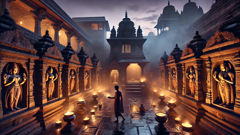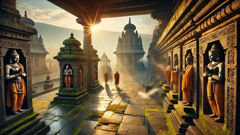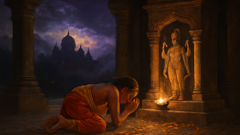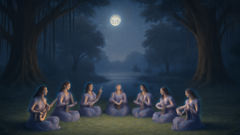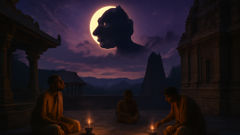Introduction
On the river-bent plains and the forested slopes of the subcontinent, where mists rise like whispered stories at dawn, there exists a cluster of narratives older than the written letter: the Mahavidyas, the ten great wisdom goddesses of the Tantric pantheon. They are not a single voice but a chorus—each goddess a facet of the same radiant, terrible, protective intelligence called the Divine Mother. To meet them is to meet contradictions: creation and dissolution braided together, tenderness and ferocity coiled like lightning, silence that births sound. For centuries, sages and seekers, poets and temple artisans have woven their lives around these goddesses, describing them in songs, sculpting them in bronze, invoking them in rites aimed at liberation, fearlessness, and knowledge. The Ten Mahavidyas—Kali, Tara, Tripura Sundari (also called Shodashi), Bhuvaneshvari, Chinnamasta, Dhumavati, Bagalamukhi, Matangi, Kamala, and Bhairavi—are both icons and archetypes. Each carries a symbolic language: the crescent moon of time, the severed head of ego, the calm lotus of abundance, the widow’s ragged cloak of loss turned into transcendence.
This retelling aims to gather those symbols and stories into an accessible narrative, attentive to the layered textures of myth and practice. We will travel from the blackened fields where Kali dances over Shiva’s prostrate body, to the starlit silence where Tara tugs a drowning devotee from the river, into the palace gardens where Tripura Sundari arranges the cosmos like fragrant flowers. At each stop we will describe the myths, the iconography, the mantras, and the living rituals tied to each Mahavidya, while also offering interpretations that speak to modern seekers—artists, poets, therapists, and pilgrims—who find in these goddesses a mirror for inner transformation. Above all, this is a story about how women of the divine, in forms that defy tidy categories, became teachers of wisdom: not just through mercy or wrath, but through a radical, embodied knowing that challenges the small self and calls it toward vastness.
As you read, imagine temples at dusk as lanterns are lit; the scent of incense and camphor thickens the air. Imagine a practitioner chanting quietly in a corner of a house shrine, finger tracing the braided beads of a rosary, while a sculptor chisels the curve of a goddess’s smile. These goddesses were first described in tantric texts and later woven into the lives of ordinary people; their stories travel like rivers through regions and languages, shifting with each mouth that tells them. Respectful of that history and careful not to turn living practice into mere folklore, this narrative seeks to reveal the Mahavidyas as both mythic presence and enduring psychology, as teachers of courage and of the subtle art of knowing when to hold and when to let go.
Origins, Symbols, and the First Five Mahavidyas: Kali, Tara, Tripura Sundari, Bhuvaneshvari, Chinnamasta
In the layered cosmology of Shakta Tantra, the Mahavidyas arise not as separate entities created by an external masculine god, but as emanations of the supreme feminine intelligence—Mahashakti—who manifests in multiple modes to teach different kinds of knowledge. The origin myths vary by region and lineage, but one recurrent image is of a furious tandem between creation and destruction: the devas (gods) request the mother’s aid against demonic forces, and the mother splits herself into fierce forms to restore cosmic balance. The first five Mahavidyas—Kali, Tara, Tripura Sundari, Bhuvaneshvari, and Chinnamasta—often serve as the earliest points of entry for a seeker because of their vivid iconography and the depth of their symbolism.

Kali is usually first on every list, and for good reason. A black or dark-blue goddess, hair loose and flowing, tongue extended, she stands upon the broken, prostrate body of Shiva. Her visage is paradoxical: terrifying in war, tender in mercy. Kali’s story is woven into both pan-Indian and tantric tales. In a celebrated narrative, the world is threatened by a demon whose power grows as the gods’ anger swells. The mother manifests as Kali to absorb that anger and transform it. Her blackness is not nihilistic emptiness but a womb-like field that contains all colors; her garland of skulls catalogs the cycles of time, each head a letter of knowledge. Iconographically, Kali’s sword severs ignorance; her severed head represents the ego whose death is necessary for liberation. Temples to Kali—particularly those in Bengal and parts of eastern India—bear witness to a living cult in which she is both feared and embraced. Devotees bring offerings not to placate but to align themselves with a power that strips what is false and reveals what is real.
Tara, the compassionate savior, often appears next. In syncretic forms she shares aspects with the Buddhist Tara while retaining distinct Shakta qualities: she is a refuge, a guide across the ocean of suffering. Mythic stories tell of Tara rescuing sailors lost in stormy waters and pulling devotees from literal or metaphorical chasms. In Tantra, Tara’s mantra and yantra are used to cut through fear, a function that maps onto the psychospiritual practice of cultivating fearless compassion. Her color varies—green, blue, or white depending on the lineage—and her iconography often includes a severed head or a small lotus. Devotional songs describe her as a mother who reads the secret language of one’s heart and replies with a hand that steadies.
Tripura Sundari, also known as Shodashi or Lalita, embodies beauty and sovereign grace. Representing the subtle and refined dimension of consciousness, she is associated with the world of three cities (tripura): the waking, dream, and deep-sleep states, or alternately the three kinds of power—iccha (will), kriya (action), and jnana (knowledge). Many tantric texts present her as the supreme ruler, adorned with jewels, seated on a throne, and accompanied by music and courtly splendor. Her worship often emphasizes poetic devotion and the cultivation of harmony between sensory delight and inner refinement. For practitioners, Tripura Sundari’s teachings are about perceiving the luminous texture of reality without grasping, a discipline of clear appreciation that dissolves greed and aversion into tranquil awareness.
Bhuvaneshvari, whose name literally means 'She who sovereigns the worlds', is both mother and cosmic queen. In iconography she may sit on a throne or a globe, representing her dominion over the manifest plane. Her myths often present her as the one who organizes space itself, making the world habitable and naming its contours. As a Mahavidya she teaches the ordering of perception: how to see the world as neither an enemy nor an object to be clung to, but as an arena for ethical action and devotion. Bhuvaneshvari’s mantras are recited in rites seeking protection, auspiciousness, and the steadying of one's inner compass.
Chinnamasta, the self-decapitated goddess, arrests many modern readers with her startling image: she stands atop a copulating couple, holding her own severed head in one hand, blood spouting from her neck into the mouths of the headless torso and two attendants who drink hungrily. The shock is deliberate; Chinnamasta is a supreme teacher about the economy of life-force and the paradoxes of liberation. Her severed head symbolizes the transcendence of identity; the flowing blood is the very life that nourishes the world—and also the practitioner's own passionate impulse transformed into spiritual fuel. She demonstrates that sacrifice is not denial but the transmutation of desire into awareness. In tantric practice her iconography and rites are potent, aimed at confronting attachment directly and converting its energy into higher insight.
Across these early Mahavidyas, several themes recur: the acceptance of shadow as integral to light, the insistence that spiritual knowledge often requires direct confrontation with fear, and the notion that the divine mother instructs through embodiment and paradox as much as through gentle counsel. Their mantras—short seed syllables and longer invocations—function as sonic keys to those deeper chambers of consciousness. In temple ritual, small household pujas, and the hushed, breath-counted work of a solitary sadhaka (practitioner), these goddesses continue to be called upon both for worldly needs and for the soul’s great unbinding.
Practitioners of Tantra emphasize initiation, lineage, and context. To call upon Kali or Chinnamasta without guidance is to enter a terrain where symbols are literal and the psyche may be stirred in unexpected ways. Therefore, many of the myths surrounding these goddesses also speak of gurus—teachers who ground the seeker, who teach how to use a mantra or a visualization without being consumed by the power it evokes. These stories are not merely about gods and goddesses; they are stories of transmission, how inner practices move from one human heart to another, shaped by caution and courage in equal measure.
The geographic spread of devotion to these goddesses is broad. In eastern India, Kali’s shrines are among the busiest; in the Himalayas, Tara’s hilltop temples attract pilgrims who climb in the cold light of dawn; Tripura Sundari’s worship retains strong footholds in South India and in island communities where courtly imagery of the goddess has long been woven into local aesthetic life. Chinnamasta’s temples are rarer but present in certain tantric centers where ritual specialization is preserved. Each site offers a living demonstration that these goddesses are not artifacts but active presences—voices that shape how people speak of fear, generosity, sorrow, and joy.
To read the Mahavidyas as only myth is to miss their role as a pedagogy of the self. Kali teaches the death of ego as a necessary doorway; Tara models compassion that moves from empathy into rescue; Tripura Sundari refines the senses into instruments of sacred perception; Bhuvaneshvari orders the world so the heart can act with clarity; Chinnamasta transfigures eros into pure, unbounded energy. Together they begin a curriculum: a set of nine or ten ways—to see, to be, to transform—each a different kind of wisdom that the mother offers to those who ask with sincerity and steady breath.
The Remaining Five Mahavidyas and Their Living Traditions: Dhumavati, Bagalamukhi, Matangi, Kamala, Bhairavi; Rituals, Psychology, and Modern Resonance
The second half of the Ten Mahavidyas—Dhumavati, Bagalamukhi, Matangi, Kamala, and Bhairavi—draw the seeker further into paradox, social critique, and the subtle transmutation of ordinary life into a field of insight. These goddesses often invert social expectations; several appear in forms that ancient and modern audiences alike might initially consider inauspicious. Tantra teaches that auspiciousness and inauspiciousness are two lenses rather than two absolute values—each goddess, in her way, dismantles the neat categories that the world relies upon.
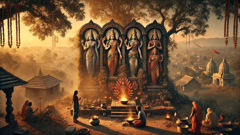
Dhumavati is the widow goddess: ash-gray, sometimes described as ragged, sometimes saturnine, she lives at the edges of society in the smoke of cremation grounds. Her iconography is intentionally discomforting to those attached to social conventions. But Dhumavati’s teachings are profound: she is the teacher of loss, the deep teacher who shows that pain and abandonment, if faced squarely, open a passage to freedom. In some tantric rites, Dhumavati is propitiated by those who feel bereft or by those wishing to overcome the fear of becoming nothing. Her widowhood is a symbol of renunciation and nonattachment, and artists often portray her with a low, almost sardonic smile that suggests knowledge born of solitude. Psychologically, Dhumavati offers a necessary lesson for anyone who has experienced loss: that the empty place left behind is also a space for a new kind of vision.
Bagalamukhi, the paralyzer and establisher of stillness, holds the tongue of a demon—literally halting speech and action—and thus teaches the worth of silence and focused will. Her devotees invoke her to still hostile forces or to gain triumph in legal, political, and hostile situations. Bagalamukhi’s power is precise: she does not indiscriminately destroy but immobilizes that which must be stopped. The symbolism extends inward; in meditation, Bagalamukhi represents the bridle placed on the mind’s habitual chatter so that deeper concentration can settle. Her rites are often esoteric and lineaged, emphasizing the discipline of restraint rather than mere suppression.
Matangi is the goddess of outcaste speech and raw creativity. Often associated with the forest and with marginal voices, Matangi presides over music, eloquence, and the transgressive arts. She is sometimes pictured as dark-complexioned and accompanied by a parrot or a veena (a stringed musical instrument). As a Mahavidya she exemplifies how the sacred can arise from places deemed impure by social standards. Poets and musicians have long invoked Matangi to unblock inspiration, and her iconography honors the truth that art commonly springs from edges: the marketplaces, the docks, the margins where different cultures meet.
Kamala, in striking contrast, is the lotus goddess of abundance and serene prosperity; she shares many attributes with Lakshmi but within the Mahavidya schema carries a distinct tantric coloring. Kamala’s lotus suggests wealth that is both worldly and spiritual: affluence balanced with purity, thriving without clinging. Her mantras and rites are used by those seeking material well-being that does not harden the heart. She teaches generosity as an art; her presence softens greed by demonstrating the joyful reciprocity of giving.
Bhairavi, the fierce crimson goddess, rounds out the set with concentrated intensity. She is the warrior of consciousness who slices through dross with a blade of uncompromising clarity. Her iconography includes weapons and a gait that suggests movement through battlefield and inner storm alike. Bhairavi’s discipline is ascetic and ecstatic at once: she asks for courage, for the surrender of complacency, for a heart willing to be broken open. She is often associated with the final stages of the spiritual journey, where illusions fall away and only raw, luminous awareness remains.
Together, these five complete the cycle begun by the first five: Dhumavati shows the necessity of encountering loss; Bagalamukhi demonstrates the power of disciplined stillness; Matangi opens the door of marginal creativity; Kamala balances abundance with grace; Bhairavi calls for final, fearless clarity. The sequence is not strictly linear—many tantric teachers insist on a tailor-made approach based on the seeker’s temperament—but as a whole, the Mahavidyas function like a full curriculum of becoming.
Beyond their mythic narratives and symbolic teachings, the living traditions around the Mahavidyas reveal how adaptive these goddesses have been. In some regions, household shrines supplement village temples: an oil lamp before a small image of Kamala, a charcoal smudge for Dhumavati in a corner where mourners gather. In tantric akharas and lineages, particular goddesses are emphasized for their ritual efficacy: Bagalamukhi for legal contests, Tara for safe crossing, Kali for decisive transformation. Modern practitioners—scholars, artists, social activists—often reinterpret these forms. Matangi, for instance, has become a patron for writers and musicians seeking permission to speak truth from the margins; Dhumavati, surprisingly, has inspired grief counselors and therapists working with trauma, who find in her austere compassion a language for consensual discomfort and eventual healing.
The Mahavidyas also surface in material culture: temple architecture, folk paintings, folk songs, and festival dramas. In Bengal the chant of Kali resounds not only in temple rituals but in the pages of nineteenth-century poetry and in modern films; in Himachal and Kashmir, Tara’s festivals mark safe passages for newly married couples and for mountain travelers. Across the subcontinent, artists continue to carve, paint, and sing these goddesses, offering each generation a fresh lens. Women devotees, in particular, have historically found in the Mahavidyas templates for empowerment: these goddesses validate rage, sexual agency, widowhood, and maternal tenderness all at once, refusing to reduce female divinity to a single, domesticated role.
Modern psychology finds in the Mahavidyas an archetypal grammar for inner work. Therapists and depth psychologists have sometimes used Mahavidya imagery to frame stages of healing: Dhumavati’s acceptance of grief, Kali’s alchemical destruction of false identity, Chinnamasta’s transmutation of libido into creative power. While such applications must be culturally sensitive and grounded in ethical practice, there is a surprising resonance between tantric methods—visualization, mantra, ritual enactment—and contemporary therapeutic techniques that use symbolic enactment to process trauma and reclaim agency.
The tension between secrecy and openness has always surrounded the Mahavidyas. Traditional tantric rites included initiatory protocols precisely because the imagery they mobilized could be overwhelming without proper guidance. Yet the goddesses’ images have also long been democratized: folk hymns, oral tales, and village festivals spread their presence beyond the cloistered temple. This duality—esoteric lineage and popular accessibility—is part of what has allowed the Mahavidyas to endure. They can be approached as inner psychologies, as gods to be propitiated for immediate worldly ends, or as poetic metaphors for deep spiritual transformation. For those willing to listen, each goddess offers a distinct voice: an insistence that the way through life’s deepest knots is not by avoiding contradiction but by learning to hold it with attention.
Finally, pilgrimage remains a living thread. Shrines dedicated to one or several Mahavidyas scatter across riverbanks, hilltops, and temple towns. Pilgrims come with varied intentions: some seek wealth, some revenge, some release from suffering. Many return with stories that read like myth themselves: a late-night vision of Kali stepping out of a smokey alcove; a sudden clarity by a temple tank after chanting Tara’s mantra; the inexplicable arrival of funds after an offering to Kamala. These modern tales echo the ancient ones, reminding us that the Mahavidyas are not mere relics of a bygone era but dynamic presences shaping human lives in ways both intimate and public.
Conclusion
The Ten Mahavidyas form a mythic school that teaches through striking images and paradoxical acts. They refuse to be simplified; each goddess announces a distinct pedagogy that meets human life at its most urgent points—fear, desire, loss, power, creativity, and final clarity. To approach the Mahavidyas is to accept that wisdom often arrives in forms that unsettle us. Kali’s dark liberation, Tara’s steady compassion, Tripura Sundari’s refined perception, Bhuvaneshvari’s cosmic ordering, Chinnamasta’s radical sacrifice, Dhumavati’s austerity, Bagalamukhi’s stilling force, Matangi’s marginal creativity, Kamala’s generous abundance, and Bhairavi’s cutting clarity together map the inner terrain of the seeker. They also map social realities: the way marginal voices contain valuable knowledge, the way grief can be instructive, the way fierce protectiveness can heal rather than harm. Modern devotees, artists, and pilgrims keep these stories alive, adapting rituals and reinterpretations while retaining the core lesson that the mother’s wisdom is never a single answer but an ongoing conversation. If you listen closely, the Mahavidyas teach not only with myths but with questions—inviting each of us to step into complexity, to hold contradictions, and to discover how the many faces of the divine mother might mirror the many faces within ourselves.

